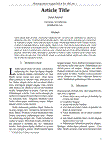| Summary: | In common with poultry or salmon, shrimp have a dietary requirement for 40 or soessential nutrients (for review of the dietary nutrient requirements of shrimp seeBoonyaratpalin, 1996; Cuzon et al. 2004; Conklin & Tacon, 2001; D’Abramo, Conklin &Akiyama, 1997; Kanazawa, 1995; O’Keefe, 1998; Shiau, 1998; Teshima et al., 1993;Wang & Liang, 2001). However, in marked contrast to existing commercial poultry andsalmon farming operations where animals are raised almost exclusively within intensivefarming systems and fed nutritionally-complete artificially compounded diets for theirentire life cycle (Beveridge, 2004; Leeson & Summers, 1997), shrimp are currentlyfarmed under a wide range of different production systems and fed an equally diversearray of different foods and feeding strategies throughout their life cycle (Cuzon et al.2004; Jory et al. 2001; Tacon, 2002).
|
|---|
